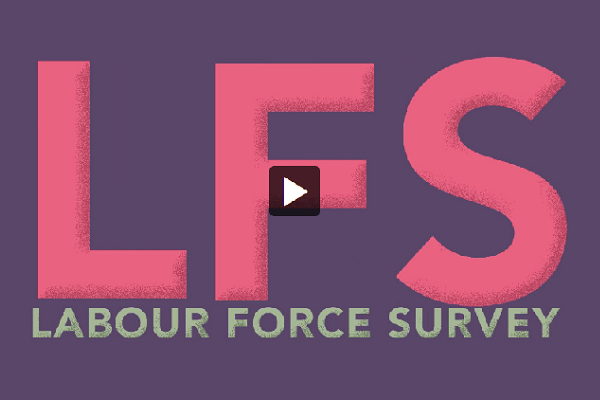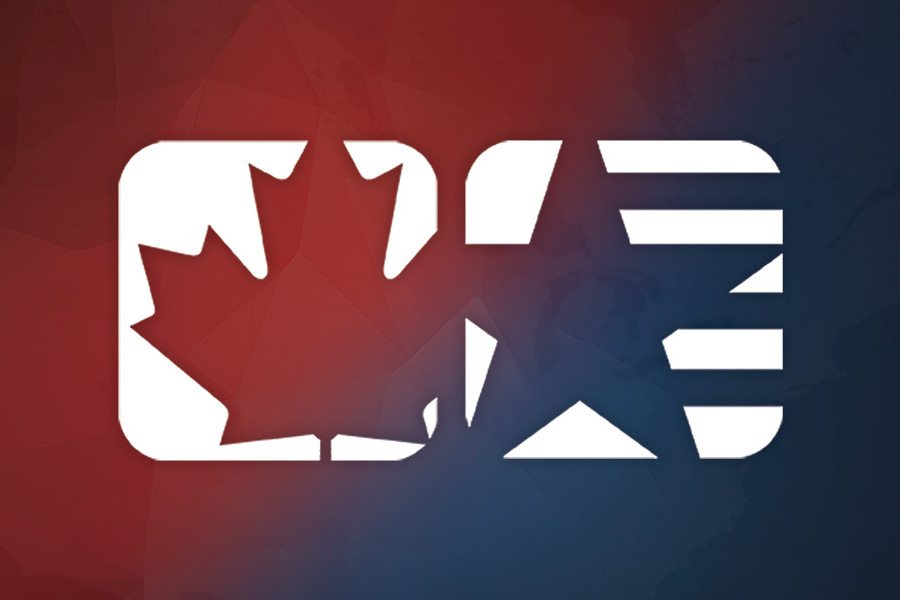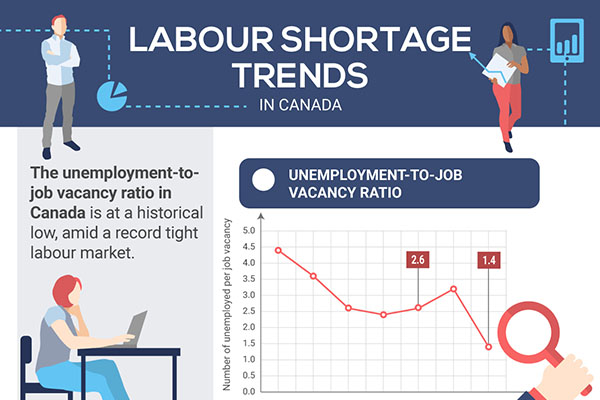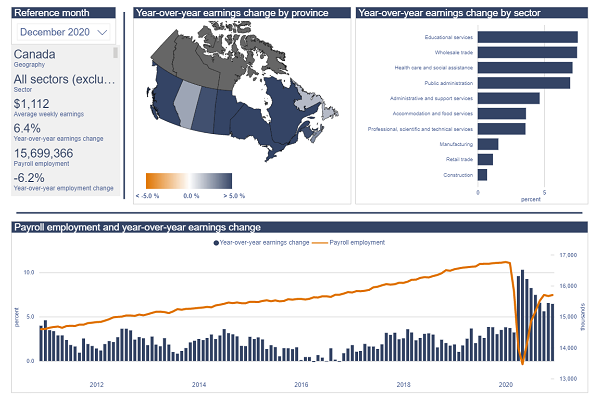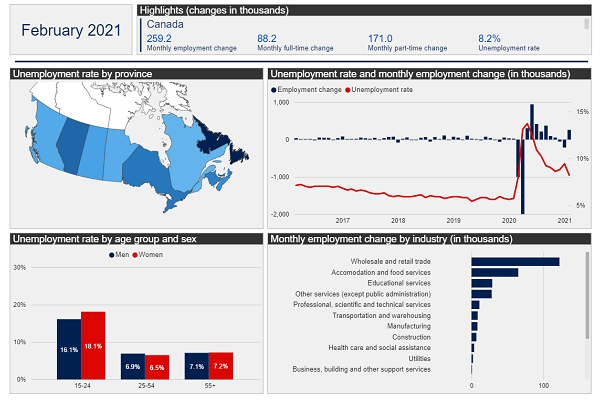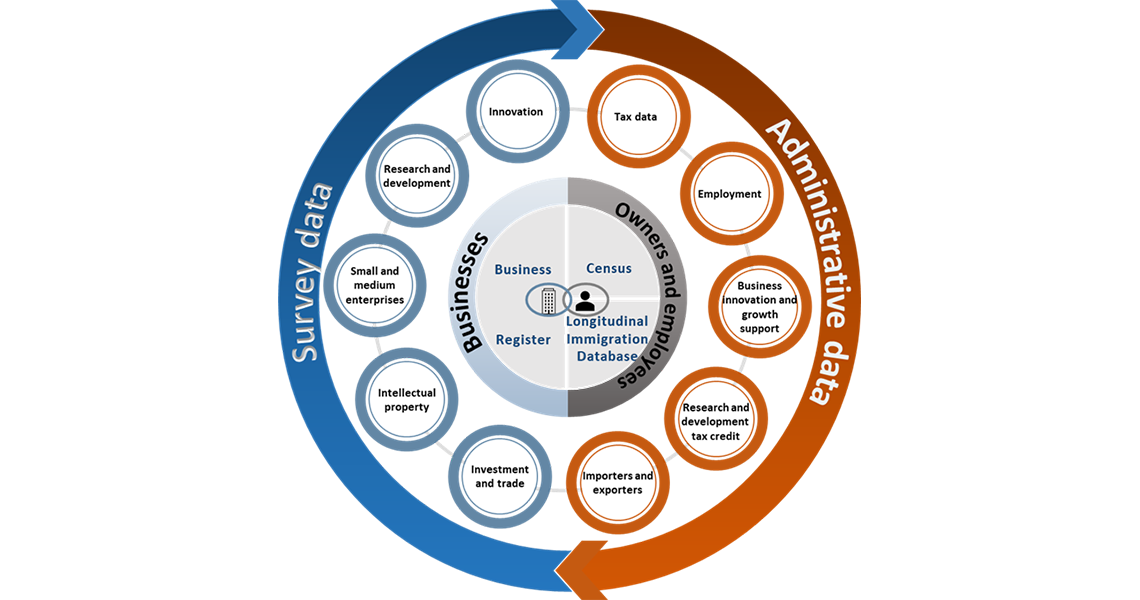Archived - Canadian Survey on Business Conditions, second quarter of 2021
Business or organization information
1. Which of the following categories best describes this business or organization?
- Government agency
- Private sector business
- Non-profit organization
- Who does this organization primarily serve?
- Households or individuals
e.g., child and youth services, community food services, food bank, women's shelter, community housing services, emergency relief services, religious organization, grant and giving services, social advocacy group, arts and recreation group - Businesses
e.g., business association, chamber of commerce, condominium association, environment support or protection services, group benefit carriers (pensions, health, medical)
- Households or individuals
- Who does this organization primarily serve?
- Don't know
2. In what year was this business or organization first established?
Year business or organization was first established:
OR
1: Don't know
3. In the last 12 months, did this business or organization conduct any of the following international activities?
Select all that apply.
- Export goods or services outside of Canada
- Make investments outside of Canada
- Sell goods to businesses or organizations in Canada who then resold them outside of Canada
- Import goods or services from outside of Canada
- Include both intermediate and final goods.
- Relocate any business or organizational activities or employees from another country into Canada
- Exclude temporary foreign workers.
- Engage in other international business or organizational activities
OR - None of the above
4. Over the next three months, how are each of the following expected to change for this business or organization?
Exclude seasonal factors or conditions.
- Number of employees
- Increase
- Stay about the same
- Decrease
- Not applicable
- Vacant positions
- Increase
- Stay about the same
- Decrease
- Not applicable
- Sales
- Increase
- Stay about the same
- Decrease
- Not applicable
- Selling price of goods and services offered by this business or organization
- Increase
- Stay about the same
- Decrease
- Not applicable
- Demand for products and services offered by this business or organization
- Increase
- Stay about the same
- Decrease
- Not applicable
- Imports
- Increase
- Stay about the same
- Decrease
- Not applicable
- Exports
- Increase
- Stay about the same
- Decrease
- Not applicable
- Operating income
- Increase
- Stay about the same
- Decrease
- Not applicable
- Operating expenses
- Increase
- Stay about the same
- Decrease
- Not applicable
- Profitability
- Increase
- Stay about the same
- Decrease
- Not applicable
- Capital expenditures
e.g., machinery, equipment- Increase
- Stay about the same
- Decrease
- Not applicable
- Training expenditures
- Increase
- Stay about the same
- Decrease
- Not applicable
Business or organization obstacles
5. Over the next three months, which of the following are expected to be obstacles for this business or organization?
Select all that apply.
- Shortage of labour force
- Recruiting skilled employees
- Retaining skilled employees
- Shortage of space or equipment
- Rising cost of inputs
- An input is an economic resource used in a firm's production process.
e.g., labour, capital, energy and raw materials - Difficulty acquiring inputs, products or supplies domestically
- Difficulty acquiring inputs, products or supplies from abroad
- Maintaining inventory levels
- Insufficient demand for goods or services offered
- Fluctuations in consumer demand
- Attracting new or returning customers
- Cost of insurance
- Transportation costs
- Obtaining financing
- Government regulations
- Travel restrictions and travel bans
- Increasing competition
- Challenges related to exporting goods and services
- Maintaining sufficient cash flow or managing debt
- Speed of internet connection
- Intellectual property protection
- Other
- Specify other:
- None of the above
Flow condition: If the business or organization is a private sector business, go to Q6. Otherwise, go to Q9.
Expectations for the next year
6. In the next 12 months, are there any plans to expand or restructure this business, or acquire or invest in other businesses?
Restructuring involves changing the financial, operational, legal or other structures of a business to make it more efficient or more profitable.
- Yes
- Does this business plan to:
Select all that apply.- Expand current location of this business
- Expand this business to other locations
- Restructure this business
- Acquire other businesses or franchises
- Invest in other businesses
- Does this business plan to:
- No
- Don't know
7. In the next 12 months, are there any plans to transfer, sell or close this business?
- Yes
- Does this business plan to:
- Transfer to family members without money changing hands
- Sell to family members
- Sell to employees
- Sell to external parties
- Close the business
- Don't know
- Does this business plan to:
- No
- Don't know
Flow condition: If "Close the business" is selected in Q7, go to Q8. Otherwise, go to Q9.
8. Is this business or organization planning to permanently close in the next 12 months primarily due to either of the following?
- The pandemic
- Business performance prior to the pandemic
- None of the above
Workforce changes
9. Over the next 12 months, does this business or organization plan to do any of the following?
Select all that apply.
- Provide training to current employees in a different skill set
- Lay off staff whose skills and knowledge no longer meet this business's or organization's needs
- Lay off staff due to continued lack of demand
- Hire employees living outside of this business's or organization's immediate vicinity to carry out work remotely
- Hire staff with technical skills that current employees lack
- Hire staff with management skills that current employees lack
- Hire staff who have other skills or knowledge that current employees lack
- Hire external contractors who have skills or knowledge that current employees lack
OR - None of the above
10. Over the next 12 months, does this business or organization plan to increase spending on employee training to do any of the following?
Include both current and new employees.
Select all that apply.
- Prepare for when the economy recovers
- Develop new skills to improve this business's or organization's competitiveness
- Mitigate potential labour shortages when the economy recovers
- Keep up with any future industry changes of this business or organization
- Other
- Specify other:
- None of the above
Workforce challenges
11. Over the next three months, to what extent will each of the following be a challenge for this business or organization with regards to the workforce?
- Finding qualified workers
- Very challenging
- Somewhat challenging
- Not challenging
- Not applicable
- Don't know
- Recruiting qualified workers
- Very challenging
- Somewhat challenging
- Not challenging
- Not applicable
- Don't know
- Retaining qualified workers
- Very challenging
- Somewhat challenging
- Not challenging
- Not applicable
- Don't know
- Finding time and resources for training current staff
- Very challenging
- Somewhat challenging
- Not challenging
- Not applicable
- Don't know
- Finding time and resources for training new staff
- Very challenging
- Somewhat challenging
- Not challenging
- Not applicable
- Don't know
- Convincing staff that have been working remotely to return to working on-site
- Very challenging
- Somewhat challenging
- Not challenging
- Not applicable
- Don't know
- Hiring temporary foreign workers
- Very challenging
- Somewhat challenging
- Not challenging
- Not applicable
- Don't know
- Managing employees that are voluntarily working reduced hours or not working in order to take care of children
- Very challenging
- Somewhat challenging
- Not challenging
- Not applicable
- Don't know
- Employees going on short-term medical leave
- Very challenging
- Somewhat challenging
- Not challenging
- Not applicable
- Don't know
- Employees going on long-term medical leave
- Very challenging
- Somewhat challenging
- Not challenging
- Not applicable
- Don't know
Investments
12. Over the next 12 months, how likely is this business or organization to make investments in online sales or e-commerce capabilities?
- Very unlikely
- Somewhat unlikely
- Neither likely nor unlikely
- Somewhat likely
- Very likely
- Not applicable
Outreach to new customers
13. Over the last 12 months, did this business or organization use virtual connections to reach new customers, clients or partners in any of the following markets?
Include virtual meetings, virtual events, virtual trade shows, and initiating or expanding e-commerce presence.
Select all that apply.
- New international markets
- New domestic markets
- Existing international markets
- Existing domestic markets
OR - Did not use virtual connections to reach new customers, clients or partners
International markets
14. Over the next 12 months, what type of international activity does this business or organization primarily plan to focus on?
- Exports
- Imports
- Investment into international markets
- Attracting investments from international markets
- None of the above
Flow condition: If "Exports", "Imports", "Investment into international markets", or "Attracting investments from international markets" is selected in Q14, go to Q15. Otherwise, go to Q16.
15. Over the next 12 months, which international market does this business or organization primarily plan to focus on?
- United States
- Mexico
- South & Central America and the Caribbean
- Exclude Mexico.
- Europe
- Asia
- Other
Consultation and advice
16. Over the next 12 months, will this business or organization consult any of the following for advice related to opportunities or challenges?
Select all that apply.
- Friends or family
- Mentors
- Employees or colleagues in this business or organization
- External consultants
- Contacts in other businesses or organizations
- Professional or business associations
- Federal government services or programs
- Provincial or territorial government services or programs
- Teachers in a training or education setting
- Other
- Specify other:
- None of the above
Funding or credit
17. Due to COVID-19, was funding or credit for this business or organization approved or received from any of the following sources?
Select all that apply.
- Canada Emergency Business Account (CEBA)
e.g., loan of up to $40,000 for eligible small businesses and non-profits - Temporary 10% Wage Subsidy
- Canada Emergency Wage Subsidy (CEWS)
- Canada Emergency Rent Subsidy (CERS)
- Canada Emergency Commercial Rent Assistance (CECRA)
- Export Development Canada (EDC) Small and Medium-sized Enterprise Loan and Guarantee program
- Business Development Bank of Canada (BDC) Co-Lending Program for Small and Medium-sized Enterprises
- Innovation Assistance Program
- Regional Relief and Recovery Fund (RRRF)
- Provincial, Territorial or Municipal government programs
- Funding from philanthropic or mutual-aid sources
- Financial institution
e.g., term loan or line of credit - Loan from family or friends
- Other
- Specify other approved source of funding or credit :
- None of the above
Flow condition: If "None of the above" is selected in Q17, go to Q18. Otherwise, go to Q19.
18. For which of the following reasons has this business or organization not accessed any funding or credit due to COVID-19?
Select all that apply.
- Funding or credit not needed
- Waiting for approval or in process of applying
- Eligibility requirements
- Application requirements or complexity
- Lack of awareness
- Terms and conditions
e.g., interest rate, payment period - Public perception
- Other
- Specify other:
19. Has this business's or organization's credit rating been negatively affected by the pandemic?
- Yes
- No
- Don't know
Liquidity and debt
20. Does this business or organization have the cash or liquid assets required to operate for the next three months?
- Yes
- No
- Will this business or organization be able to acquire the cash or liquid assets required?
- Yes
- No
- Don't know
- Will this business or organization be able to acquire the cash or liquid assets required?
- Don't know
21. Does this business or organization have the ability to take on more debt?
- Yes
- No
- For which of the following reasons is this business or organization unable to take on more debt?
Select all that apply.- Cash flow
- Lack of confidence or uncertainty in future sales
- Request would be turned down
- Too difficult or time consuming to apply
- Terms and conditions are unfavourable
e.g., interest rate, payment period - Credit rating
- Other
- Specify other:
- For which of the following reasons is this business or organization unable to take on more debt?
- Don't know
- This business or organization does not need to take on more debt
Measures permanently adopted
22. Using a scale from 1 to 5, where 1 means "very unlikely" and 5 means "very likely", how likely is this business or organization to permanently adopt each of the following measures once the COVID-19 pandemic is over?
An employee is someone who would be issued a T4 from this business or organization.
- Online training
- 1 – Very unlikely
- 2
- 3
- 4
- 5 – Very likely
- Not applicable
- Offer more employees the possibility of teleworking or working remotely
- 1 – Very unlikely
- 2
- 3
- 4
- 5 – Very likely
- Not applicable
- Require more employees to telework or work remotely
- 1 – Very unlikely
- 2
- 3
- 4
- 5 – Very likely
- Not applicable
- Require employees to come back to on-site work
- 1 – Very unlikely
- 2
- 3
- 4
- 5 – Very likely
- Not applicable
- Increase IT infrastructure to support teleworking
- 1 – Very unlikely
- 2
- 3
- 4
- 5 – Very likely
- Not applicable
- Make investments to increase the security of telework systems
- 1 – Very unlikely
- 2
- 3
- 4
- 5 – Very likely
- Not applicable
- Adopt shiftwork to increase the distance between employees
- 1 – Very unlikely
- 2
- 3
- 4
- 5 – Very likely
- Not applicable
- Modify the work space to increase the distance between employees
- 1 – Very unlikely
- 2
- 3
- 4
- 5 – Very likely
- Not applicable
- Diversify supply chains within Canada
- 1 – Very unlikely
- 2
- 3
- 4
- 5 – Very likely
- Not applicable
- Diversify supply chains outside Canada
- 1 – Very unlikely
- 2
- 3
- 4
- 5 – Very likely
- Not applicable
- Reduce hiring of temporary foreign workers
- 1 – Very unlikely
- 2
- 3
- 4
- 5 – Very likely
- Not applicable
- Increase online sales capacity
- 1 – Very unlikely
- 2
- 3
- 4
- 5 – Very likely
- Not applicable
- Increase contactless delivery or pickup options
- 1 – Very unlikely
- 2
- 3
- 4
- 5 – Very likely
- Not applicable
- Reduce the physical space used by this business or organization
- 1 – Very unlikely
- 2
- 3
- 4
- 5 – Very likely
- Not applicable
- Increase the physical space used by this business or organization
- 1 – Very unlikely
- 2
- 3
- 4
- 5 – Very likely
- Not applicable
- Increase investments in training
- 1 – Very unlikely
- 2
- 3
- 4
- 5 – Very likely
- Not applicable
Technology and automation
23. Over the next 12 months, does this business or organization plan to adopt or incorporate any of the following technologies?
Select all that apply.
- Software or hardware using artificial intelligence
e.g., machine learning, predictive technology, virtual personal assistants, online customer support bots, image or speech recognition - Robotics
- Automation of certain tasks
e.g., through the use of robots or computer algorithms - Cloud computing
- Cloud computing: services that are used over the internet to access software, computing power, or storage capacity.
e.g., Microsoft 365®, Google Cloud™, Dropbox™ - Collaboration tools
e.g., Zoom™, Microsoft Teams™, Slack™ - Security software tools
e.g., anti-virus, anti-spyware, anti-malware, firewalls - Software or databases for purposes other than telework and online sales
- Digital technology to move business operations or sales online (for purposes other than teleworking or remote working)
OR - None of the above
Flow condition: If at least one technology is selected in Q23, go to Q24. Otherwise, go to Q25.
24. Using a scale from 1 to 5, where 1 means "not at all challenging" and 5 means "extremely challenging", how challenging are the following for this business or organization when adopting or incorporating technologies?
- Reorienting business strategy and processes
- 1 – Not at all challenging
- 2
- 3
- 4
- 5 – Extremely challenging
- Not relevant
- Retraining employees with skills to use new technologies and processes
- 1 – Not at all challenging
- 2
- 3
- 4
- 5 – Extremely challenging
- Not relevant
- Hiring workers with skills in technologies
- 1 – Not at all challenging
- 2
- 3
- 4
- 5 – Extremely challenging
- Not relevant
- Finding suitable hardware or software vendors
- 1 – Not at all challenging
- 2
- 3
- 4
- 5 – Extremely challenging
- Not relevant
- Ensuring high-speed connectivity
- 1 – Not at all challenging
- 2
- 3
- 4
- 5 – Extremely challenging
- Not relevant
- Integrating new digital technologies into this business's or organization's existing technology infrastructure
- 1 – Not at all challenging
- 2
- 3
- 4
- 5 – Extremely challenging
- Not relevant
- Having access to financial resources to invest in new technologies
- 1 – Not at all challenging
- 2
- 3
- 4
- 5 – Extremely challenging
- Not relevant
- Ensuring security and privacy of data
- 1 – Not at all challenging
- 2
- 3
- 4
- 5 – Extremely challenging
- Not relevant
25. Was this business or organization impacted by more, less or approximately the same number of cyber security incidents in 2020 compared to 2019?
A cyber security incident is any unauthorized attempt, whether successful or not, to gain access to, modify, destroy, delete or render unavailable any computer network or system resource.
- More
- Less
- Approximately the same
- This business or organization has not experienced any cyber security incidents in 2019 or 2020
- Don't know
26. Over the next 12 months, how much will 5G availability impact the operations or services of this business or organization?
5G is the latest standard for high-speed cellular networks.
- No impact
- A small impact
- A moderate impact
- A major impact
- Don't know
International trade
27. To what degree is this business or organization impacted by changes to international trade agreements or provisions?
e.g., Buy American, Brexit
- Not at all
- Low
- Medium
- High
- Don't know
Future outlook
28. Over the next 12 months, what is the future outlook for this business or organization?
- Very optimistic
- Somewhat optimistic
- Not optimistic
- Don't know
29. How long can this business or organization continue to operate at its current level of revenue and expenditures before having to consider the following options?
- Laying off staff:
- Less than 1 month
- 1 month to less than 3 months
- 3 months to less than 6 months
- 6 months to less than 12 months
- 12 months or more
- Not applicable
- Don't know
- Closure or bankruptcy:
- Less than 1 month
- 1 month to less than 3 months
- 3 months to less than 6 months
- 6 months to less than 12 months
- 12 months or more
- Not applicable
- Don't know
Flow condition: If the business or organization is a private sector business, go to Q30. Otherwise, go to "Contact person".
Ownership
(i) The groups identified within the following questions are included in order to gain a better understanding of the impact of COVID-19 on businesses or organizations owned by members of various communities across Canada.
30. What percentage of this business or organization is owned by women?
Provide your best estimate rounded to the nearest percentage.
Percentage:
OR
1: Don't know
31. What percentage of this business or organization is owned by First Nations, Métis or Inuit peoples?
Provide your best estimate rounded to the nearest percentage.
Percentage:
OR
1: Don't know
32. What percentage of this business or organization is owned by immigrants to Canada?
Provide your best estimate rounded to the nearest percentage.
Percentage:
OR
1: Don't know
33. What percentage of this business or organization is owned by persons with a disability?
Include visible and non-visible disabilities.
Provide your best estimate rounded to the nearest percentage.
Percentage:
OR
1: Don't know
34. What percentage of this business or organization is owned by LGBTQ2 individuals?
The term LGBTQ2 refers to persons who identify as lesbian, gay, bisexual, transgender, queer and/or two-spirited.
Provide your best estimate rounded to the nearest percentage.
Percentage:
OR
1: Don't know
35. What percentage of this business or organization is owned by members of visible minorities?
A member of a visible minority in Canada may be defined as someone (other than an Indigenous person) who is non-white in colour or race, regardless of place of birth.
Provide your best estimate rounded to the nearest percentage.
Percentage:
OR
1: Don't know
Flow condition: If more than 50% of this business or organization is owned by members of visible minorities, go to Q36. Otherwise, go to "Contact person".
36. It was indicated that a percentage of this business or organization is owned by members of visible minorities. Please select the categories that describe the owner or owners.
Select all that apply.
- South Asian
e.g., East Indian, Pakistani, Sri Lankan - Chinese
- Black
- Filipino
- Latin American
- Arab
- Southeast Asian
e.g., Vietnamese, Cambodian, Laotian, Thai - West Asian
e.g., Afghan, Iranian - Korean
- Japanese
- Other group
- Specify other group:
- Prefer not to say

 Earnings, wages and non-wage benefits
Earnings, wages and non-wage benefits Employment and unemployment
Employment and unemployment Employment insurance, social assistance and other transfers
Employment insurance, social assistance and other transfers Hours of work and work arrangements
Hours of work and work arrangements Job vacancies, labour mobility and layoffs
Job vacancies, labour mobility and layoffs